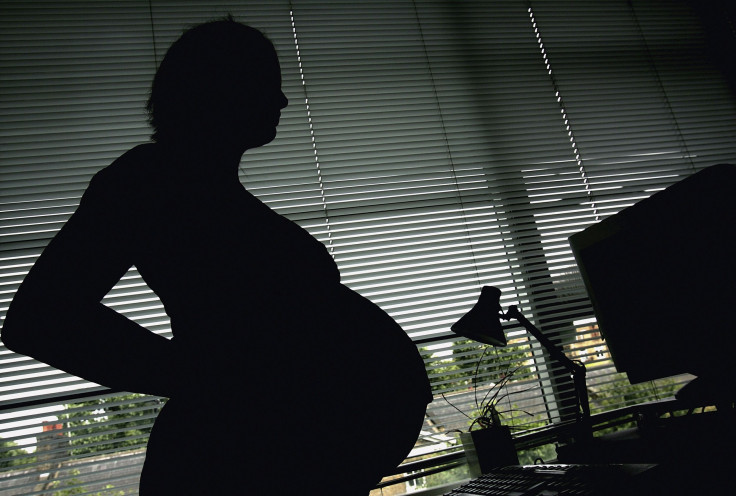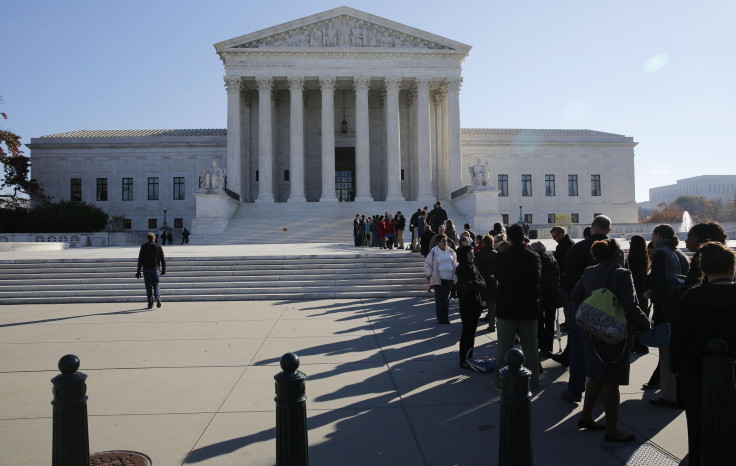The Supreme Court, UPS And The Economics Of Pregnancy Discrimination

As an “air driver” for UPS, Peggy Young would head to the airport in the early mornings to pick up packages and letters for delivery. After she became pregnant in 2006, she brought her employer a doctor’s note that imposed a 20-pound lifting restriction during her pregnancy. Young believed she could still do the bulk of her job, perhaps with occasional help from co-workers, or else take a “light duty” assignment -- the same accommodation, she has argued in court papers, that UPS made for drivers with injuries.
Instead, Young says, she was forced to take unpaid leave from her job, losing her income and medical coverage before her baby was born.
Young’s fight against her former employer lands at the Supreme Court Wednesday. The case centers on a 1970s-era law, the Pregnancy Discrimination Act, with far-reaching economic consequences for individual families and for U.S. productivity on the whole.
“What we really see is women losing key benefits such as health insurance, being sent out without income,” says Dina Bakst, co-president of the New York-based nonprofit A Better Balance, which runs a free legal clinic for workers.
Those financial setbacks are bad enough when a mother has a new child. But, according to a friend-of-the-court brief that A Better Balance and the American Civil Liberties Union filed in the case, pregnancy discrimination also has long-term ramifications. “Women who are forced out of the workplace when pregnant also forfeit other earned long-term benefits, including 401K contributions, short-term disability benefits, seniority, pension, social security contributions, and other benefits,” the brief states.
“We need the productivity of everyone to help continue to grow the GDP and we also need to make sure women are taken care of, so they can support their families,” says Margot Dorfman, CEO of the U.S. Women’s Chamber of Commerce, which submitted a brief to the court in support of Young. Were it not for the presence of women in the workforce over the past four decades, she says, gross domestic product would be one-quarter less than it is today.
UPS has changed the pregnancy accommodation policy at issue in the case, the company announced in its own Supreme Court brief this fall. Starting Jan. 1, UPS said it will provide “light duty work” to pregnant employees with lifting restrictions, to the same extent it accommodates workers injured on the job. But the company maintains the change is a matter of voluntary corporate policy, not a legal requirement.
Young lost her initial case against UPS, and the 4th U.S. Circuit Court of Appeals, which is based in Richmond, Virginia, upheld that decision. The federal appeals court determined that the UPS policy at the time was “pregnancy blind” and that for purposes of the Pregnancy Discrimination Act, Young wasn't “similar” to other types of employees who were injured on the job, or had disabilities that qualified under the Americans with Disabilities Act. The decision left Young on the hook for more than $8,000 in UPS attorney’s fees, the Washington Post reported, pending the outcome in the Supreme Court.
The Pregnancy Discrimination Act requires employers to treat pregnant workers the same as other employees who are “similar in their ability or inability to work.” And UPS argues that while it did grant workplace accommodations to employees injured on the job, it treated Young just as it treated anyone injured off the job.
The law “does not mandate accommodation or other special treatment for pregnant employees,” the brief says. “Because UPS treated [Young] the same as it did other employees with similar lifting restrictions resulting from an off-the-job injury or condition, UPS did not discriminate against [Young] on account of her pregnancy.”
Young’s attorneys argue that by accommodating certain groups of drivers with lifting restrictions, but not a pregnant driver, UPS “plainly violated” the law.
“Had her lifting restriction resulted from an on-the-job injury rather than pregnancy,” the company’s brief states, “there is no question that Peggy Young would have received an accommodation that allowed her to continue working.”

Young is hardly alone in her claims. Between 1997 and 2011, annual pregnancy discrimination complaints lodged with both the Equal Employment Opportunity Commission and local Fair Employment Practices Agencies climbed from 3,977 to 5,797. (For recent years, the EEOC no longer calculates the local FEPA complaints in annual totals).
“In the 21st century, when 40 percent of mothers are the sole or chief breadwinners in their families, there is still an astonishing level of pregnancy discrimination,” says Joan Williams, director of the Center for WorkLife Law at the University of California's Hastings College of the Law.
Young’s case is particularly important for women in low-paying and physically demanding jobs. “One of the key ways that women in low wage and blue collar jobs experience gender discrimination is that when they get pregnant, their employers commonly deny them very, very simple accommodations,” Williams says.
In a 2011 report, “Poor, Pregnant, and Fired,” the center analyzed a database of more than 2,600 lawsuits around caregiver discrimination and found that low-wage workers most frequently brought pregnancy discrimination suits. The lawsuits commonly hinged on “such small adjustments as: Allowing more frequent bathroom breaks for a pregnant plant worker; providing a stool for a pregnant assembly line worker; allowing a pregnant waitress to snack as needed; or permitting a pregnant sales floor associate to carry a water bottle,” the report found.
In the latter case, the sales floor associate -- a Walmart employee -- was fired for insubordination when she continued to carry the water bottle with her. A U.S. district court sided with Walmart in a 2009 decision.
Among the lowest-earning U.S. households, the loss of a woman’s income can be destructive. “In married-couple families with children in the bottom income quintile, nearly 70 percent of working wives are breadwinners, earning as much or more than their husbands,” according to a report last year by A Better Balance and the National Women’s Law Center. “Additionally, more than 72 percent of single mothers worked in 2011, providing critical income as heads of household.”
Just ask Armanda Legros. A recently divorced, single mother, Legros was working at an armored truck company in Long Island, New York, in 2012. Six months into her pregnancy with her second child, she pulled a stomach muscle while lifting on the job. After a two-week leave she returned to work with a doctor’s note, advising her employer of a lifting restriction, she says.
Legros didn’t foresee any problems. The majority of her work was clerical, she says, and the company had accommodated one of her co-workers who had injured his back on the job.
Instead, her employer told her she couldn’t return to work with a lifting restriction. Her boss, she says, “knew I wouldn’t be able to get that clearance” from a doctor.
“Basically I wasn’t going to choose my job over my health, and the health of my child,” she tells IB Times.
Essentially forced out of the company where she’d worked for three years, Legros lost her insurance coverage, and her apartment when she couldn’t keep up with rent. She had to rely on family and friends for help and eventually sought public assistance.
Last May, Legros testified before the U.S. Senate Health, Education, Labor and Pensions committee about her experience. “It was a very scary time, not knowing what you’re going to do, how you’re going to provide for your children,” she says. “It was a very scary, stressful time.”
Now expecting her third child this week, Legros says she’s in a better place. She works as a financial services associate at a bank, with a management culture that she describes as supportive and “humane” toward her pregnancy.
In the time since Peggy Young first filed suit in 2008, advocates can point to signs of progress nationally, too. More states have passed their own pregnancy discrimination laws. Last July, for the first time in three decades, the EEOC adopted new enforcement guidance on pregnancy discrimination, including accommodations for pregnant workers.
Legros says she didn’t know what kinds of laws, if any, applied to her situation when she had to leave her job. Now, she says, she considers herself one voice, among many, who have wanted for protections from pregnancy discrimination.
“I just feel like it goes on all the time, and it probably still goes on, and I just would really like to see a change,” she says.
© Copyright IBTimes 2024. All rights reserved.




















